OPAL



 Characteristics of the mineral.
Characteristics of the mineral.
For this group, the question is how to distinguish from a fake.
Pure opal is colorless, but almost always it is more or less milky and opaque or colored in various dull tones. Under a microscope, you can see its internal structure, which is a small silica beads located in a certain order (like honeycombs) in the mass of a silicon gel. This structure provides rainbow color play (interference), changing with the rotation of the stone. A stone of the most various colors and shades (it is stained with admixtures of iron, manganese, nickel and other elements). Transparent opals are cut, and translucent ones are made in the form of cabochons.
Opal is a silicic acid and water, an amorphous variety of quartz. More precisely, a gel of silicic acid and water of sedimentary origin (SiO2 * xH2O silicon dioxide polyhydrate). Noble opal contains from 6 to 10% of water, so opals like to be worn. When overdrying and loss of moisture, opals crack and lose their jewelry qualities. Opals also can not be stored in excess of moisture. These are soft stones, often requiring additional protection in products. Dissolve in hydrofluoric acid. Strong internal reflexes, opalescence. There are three types of jewelry opal: black opal, which has a very dark blue color with flashes of other colors; Fire opal of orange-red color and white opal (cacholong). The best collection of opals is in Vienna. 95% of the world's opal mining falls on Australia.
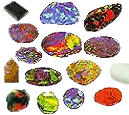 The main advantage of opal is the ability to radiate successively different beams under the influence of sunlight, to cause a variety of play of colors and shimmering when rotating inside opal. Opal can seem uniformly colored in one angle, but when turning, color flashes and flashes of colored rays appear. With the rotation of natural opal, some glare may disappear, while others may appear in the most unexpected places. Milky-white (ignoble) and fire (noble) opals can not have pronounced flashing when rotating. Opals are afraid of excessive wetness and dryness, they can first swell and then crack. The water content of noble and ignoble opals varies from 1 to 21%, occasionally higher (in a porous hydrophane contains up to 32% of water).
The main advantage of opal is the ability to radiate successively different beams under the influence of sunlight, to cause a variety of play of colors and shimmering when rotating inside opal. Opal can seem uniformly colored in one angle, but when turning, color flashes and flashes of colored rays appear. With the rotation of natural opal, some glare may disappear, while others may appear in the most unexpected places. Milky-white (ignoble) and fire (noble) opals can not have pronounced flashing when rotating. Opals are afraid of excessive wetness and dryness, they can first swell and then crack. The water content of noble and ignoble opals varies from 1 to 21%, occasionally higher (in a porous hydrophane contains up to 32% of water).
With geological aging, opal loses most of its water and turns into chalcedony, a type of quartz with a cryptocrystalline fibrous structure. In domestic conditions this is not possible, with sharp drying opal can dry, crack or even completely scatter gray into dust.
Opal - one of the most famous jewelry stones. In the countries of the East opal is a symbol of fidelity and hope. Electron-microscopic studies have established that noble opals consist of silica particles, homogeneous in size, with a diameter of 150-450 nm, located on the principle of cubic, sometimes hexagonal packing. These spherical particles, in turn, are composed of randomly arranged small globules with a diameter of 10-50 nm. The voids between the spheres are filled with amorphous silica, air, water vapor, needle-shaped or irregularly shaped crystals of tridymite and cristobalite. Equal-sized and densely packed spheres act as a three-dimensional diffraction grating (the notion of modern mathematical physics), decomposing light into its color components and thereby inducing opalescence.
The brightest color game occurs when there is a significant difference in the optical properties of spheres and cement that fills the voids between them. This takes place in black opals, which have an opalescence of unique beauty. This game is most often expressed in fire opals, in which spheres and cement between them are composed of practically the same substance. In noble opals, the size of microparticles of silica is the same and structured, for ignoble can vary greatly in shape and size and are located chaotically. We give photographs of the internal micro-structure of natural noble (left) and ignoble (right) opals made under an electron microscope.
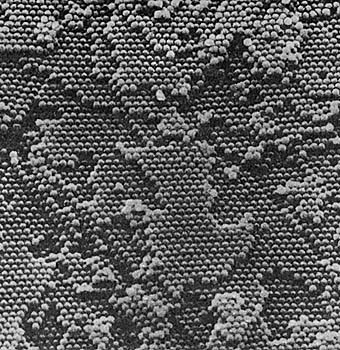

Some of the rocks consist entirely of opals - geyserite, diatomite, trefoil. The formation of inorganic opals is associated with the deposition of silica from hot volcanic waters or the decomposition of silicates under the action of water and carbon dioxide in the weathering zone. Opal of biogenic origin is composed of skeletons of diatoms and radiolarians. Color iridescent opals are used as ornamental stones.
In stores (including jewelry in the gold departments) often come synthetic white and black opals, in which the play of light is achieved due to the presence of multicolored shiny fragments with sharp and pronounced boundaries, and not due to the play of light in the internal structure of the opal itself. This is a qualitative and characteristic difference of the syna-opal from natural. For today we have not met natural opals in jewelry stores of the city, but they were at exhibitions. Synthetic opals can be made with doublets (based on) and triplets (based on coated), so it's best to contact independent experts and gemologists if buying opals (separately and in products or in gold), so as not to buy a counterfeit for an unreasonable price. Noble opal - one of the most expensive and controversial jewelry stones.
Magic properties of stones.
The most fatal stone. Talisman of talented, gifted people. He does not want to live with others. He supports all the beginnings of creative individuals, teaches them subtle foresight, promotes their spiritual development, protects against the vicissitudes of fate. Creativity extends to all kinds of human activity, a shoemaker can have it, and it can not touch any "writer" or "artist" at all. Therefore, the person himself and the people around him decide whether he is creative or not. The energy of the stone is so huge that it thoroughly disturbs ordinary people, bringing anxiety, as a rule, completely unfounded to their lives. Black opals are fatal stones of passion, exacerbating the vices of man. White opals are their opposite, the mascot of nurses and doctors, increasing patience and tolerance for others. Buddhists identify him with a lotus - a symbol of unfading spiritual purity. Fire opals are similar in their mystical qualities to rubies and other fiery stones.
Opal is a stone of deceptive hopes and illusions, obscuring the mind with empty dreams and all kinds of apprehensions. It can be worn only by very strong Pisces, Scorpions and magicians who, by changing color and gloss, can determine the approach of danger. We are talking about its European varieties, casting a fiery-ruby-red gleam or bluish-blue hues with golden sparks. Those who aspire to action, to improve their situation, find their opponent in disgrace. He also fears darkness.
Australian and Ukrainian opals have purely positive qualities and bring luck to their owners. Opal is recommended where you need to concentrate energy on achieving a high goal. This is especially true of Scorpio, whose beauty and grandeur are revealed precisely in the service of a great goal, when it is so important not to spray such a powerful energy of Scorpio in the momentary whims. Opal hinders the mundane people in achieving worldly goods, but it helps those who sacrifice personal well-being for the sake of a great goal, in the name of serving the chosen cause. Opal empowers its owners to act telepathically on the minds of others. People are unstable, with an unstable character should beware of this stone. He also brings the gift of prophecy. But if the prediction of the future was intended to harm someone, the opal lost its miraculous property. In the East opal is a stone of fidelity.


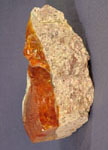



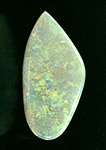
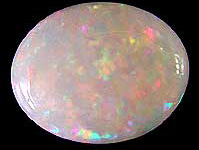

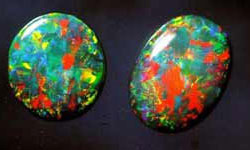



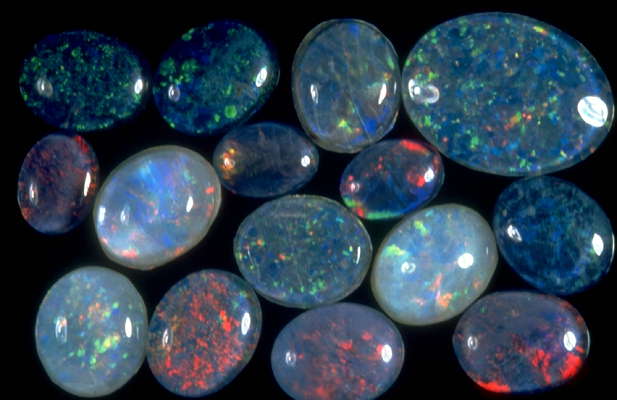
Very characteristic Ukrainian Transcarpathian chloropals take excellent mirror polish. The stone is beautiful in color; Dense and translucent differences with success can be used in stone-cutting and jewelry works. A feature of this borderline form of opal and chalcedony (which can therefore be called a half-octopus) is that this opal does not crumble into fine dust when dry, or it can crack into smaller and smaller fragments. Therefore, it is desirable to use an additional protective coating at the finishing stage of processing such opals. These opals are characteristic stones of Ukraine.
On the north-western outskirts of Uzhhorod there is an old abandoned quarry, where in 1839 E. Glocker found a stone described by him under the name Ungovarit. Later it turned out that this is not a new mineral with a special composition and structure, but a well-known opal with an admixture of clay mineral of nontronite and iron hydroxides. Because of the green color, this stone is often referred to in the literature as chloropal. However, it can be colored differently, but most often there are green tones. The color of the unvovarite is determined by the color of the nontronite and can be greenish-yellow, pistachio-green, brown, amber-yellow, red-brown, grayish-blue and black. The stone is very beautiful and slightly translucent in chips and polishes, like jade or amber.
Ungovarit is most often found among the andesite rocks of the northwestern part of the Vigolat-Gutinsky volcanic ridge. Its formation is associated with the activity of hot gases and solutions circulating in a massif of solidified lava. The gem is found in the form of nodules and nests in andesites and sporadically scattered in the most diverse parts of the lava flows. Its secretions are spherical, ellipsoidal or completely irregular in shape. In the walls of quarries it was possible to find ungovaritic fillings with a diameter of more than 2 m. In the nuclei of its largest globular discharge there is a pure translucent opal of white color with characteristic annular cracks and voids resulting from dehydration and aging of the stone. When a hammer blows, the monolithic pieces are easily broken into sharp-edged fragments. The jaws of the ungovariate from the outside usually have a green color, which is replaced by light brown and yellow towards the center. The photo shows Ukrainian opals.




Poisonous and radioactive dangerous stones and minerals
** - poisonous stones and minerals (mandatory check in the chemical laboratory + explicit indication of toxicity).
** - radioactive stones and minerals (mandatory check on the standard dosimeter + ban on open sales in the case of radioactivity over 24 milli / g / h + additional measures of population protection).
All rare stones are subject to mandatory inspection at the standard dosimeter for the permissible level of radiation and in the chemical laboratory for the absence of poisonous and evaporating components that are dangerous to humans and the environment.


Comments
When commenting on, remember that the content and tone of your message can hurt the feelings of real people, show respect and tolerance to your interlocutors even if you do not share their opinion, your behavior in the conditions of freedom of expression and anonymity provided by the Internet, changes Not only virtual, but also the real world. All comments are hidden from the index, spam is controlled.